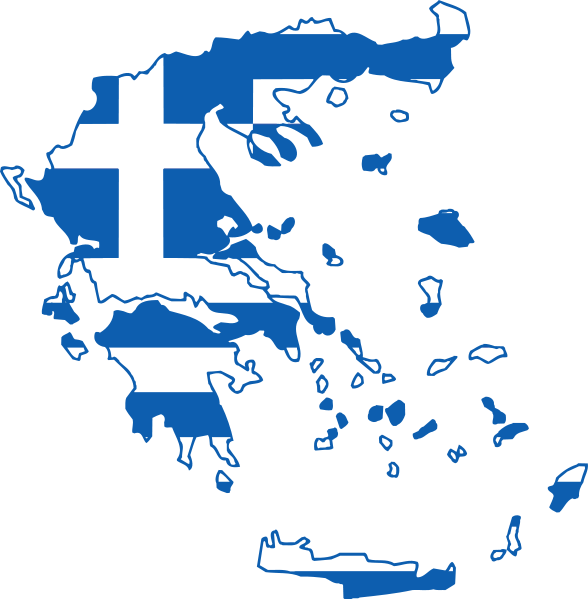Thousands of people have fled Santorini on ferries and planes, aiming to reach safety in Athens as a series of quakes continued to shake the famous Greek tourist island.
Hundreds of quakes have been registered every few minutes in recent days in the sea between the volcanic islands of Santorini and Amorgos, in the Aegean Sea, prompting authorities to shut schools in Santorini and the small nearby islands of Ios, Amorgos and Anafi until Friday.
A tremor with a magnitude of 4.9 was recorded on Tuesday by the Athens Geodynamic Institute at 2:46am GMT (12:46pm AEST) on the island, most of whose popular white and blue villages cling to steep cliffs over the sea.
Hundreds of people were seen queuing at Santorini’s port in an attempt to flee the island on ferries destined for Athens. (AP: Petros Giannakouris)
Hundreds of permanent residents and workers later rushed to a port to embark for the Greek capital.
“We have a very intense geological phenomenon to handle,” Prime Minister Kyriakos Mitsotakis said from Brussels, where he was attending a European meeting.
“I want to ask our islanders first and foremost to remain calm, to listen to the instructions of the Civil Protection (authority).”
Dozens of cars were seen packing streets alongside the port in Santorini, as people tried boarding a ferry service heading to Piraeus.
(Reuters: Alkis Konstantinidis)
Flights out of Santorini to Athens were full, Greek air carrier Aegean Airlines said on Tuesday. A total of between 2,500 and 2,700 people were expected to have flown out since Monday by the end of the day, the carrier said.
“We are going to leave because I am afraid, there are constantly earthquakes, we have to leave for the kids, so the kids can calm down,” 38-year-old Beni Ouklala, who has temporary work on the island, told Reuters.
Others were unfazed. “We will stay here, why should we leave? If something happens it happens,” 63-year-old Eftichis Diamantopouulos, a tourist boat captain, said.
Additional emergency and rescue personnel, who have been on the ground on the island coordinating the alerts and response to the quakes, have been sleeping in tents. (AP: Petros Giannakouris)
Mobile phones on the island blared with alert warnings on Monday, warning about the potential for rockslides while several earthquakes caused loud rumbles. Authorities also banned access to some seaside areas, including the island’s old port, that are in close proximity to cliffs.
“These measures are precautionary, and authorities will remain vigilant,” Civil Protection Minister Vasilis Kikilias said late on Sunday following an emergency government meeting in Athens.
“We urge citizens to strictly adhere to safety recommendations to minimise risk.”
The frequency of the quakes has worried residents and visitors.
“I have never felt anything like this and with such frequency — an earthquake every 10 or 20 minutes,” Michalis Gerontakis, who is also the director of the Santorini Philharmonic Orchestra, said.
“Everyone is anxious even if some of us hide it not to cause panic, but everyone is worried.”
“We came out yesterday and performed. Despite the earthquakes, the philharmonic performed for a religious occasion,” Gerontakis said. “When you are playing, you cannot feel the quakes but there were earthquakes when we were at the church. No one can know what will happen. People can say whatever they like, but that has no value. You cannot contend with nature.”
Santorini throngs with hundreds of thousands of tourists in the summer. It is much quieter at this time of the year, but with seismologists estimating that the intense seismic activity could take days or weeks to abate, local authorities have drafted an emergency accommodation plan.
“We have [planned for] places for shelters for the population without structures and on level surfaces, there are eight places that can accommodate people,” Santorini Mayor Nikos Zorzos said.
Some residents have voiced their fears about the quakes, with seismologists estimating the intense seismic activity could take days or weeks to abate. (Reuters: Alkis Konstantinidis)
Emergency rescue crews were also on the ground, while people were advised to stay out of coastal areas due to the risk of landslides and avoid indoor gatherings.
Some hotels started emptying their pools as they were told that the water load made buildings vulnerable and construction activities have ceased.
Greece is one of the most earthquake-prone countries in Europe as it sits at the boundary of the African and Eurasian tectonic plates whose constant interaction prompts frequent quakes.
Santorini took its current shape following one of the largest volcanic eruptions in history, around 1600 BC. The last eruption in the area occurred in 1950.
AP/Reuters







